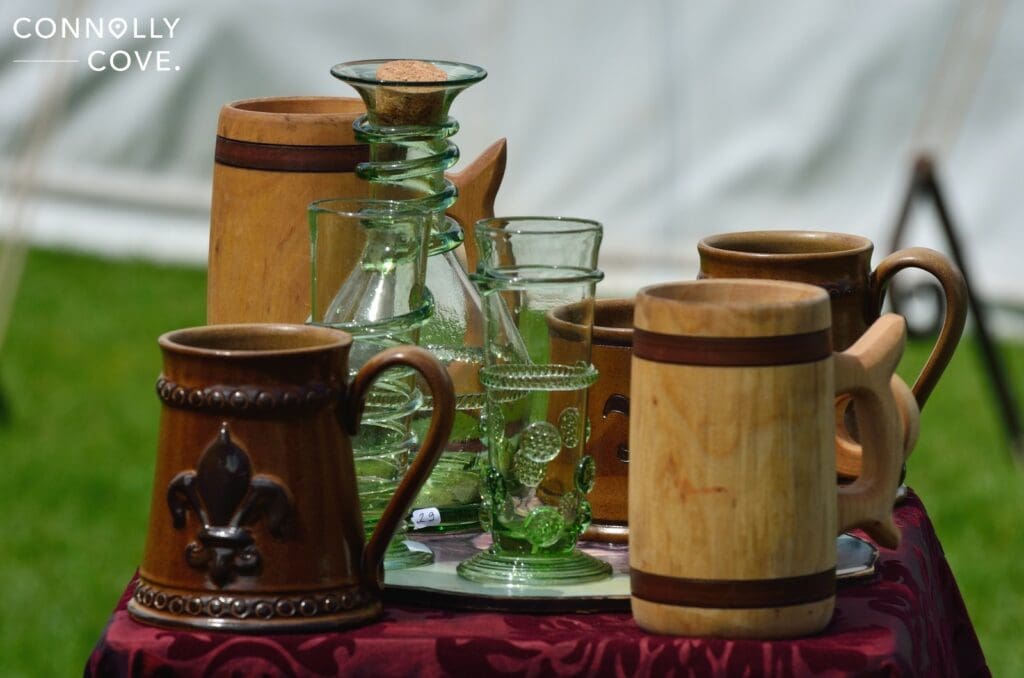Tankards: Short History of the Revived Drinking Jug

Updated On: January 23, 2024 by Aya Radwan
Imagine you’re watching a favourite period drama series with us, and the protagonist sits at the local pub, attempting to drown the day’s sorrows while pondering his next move. The bartender places a hefty drinkware on the table as the protagonist’s friends join in. This plot might be from a work of fiction, but that massive drinkware is not. The heroes clank their tankards together, with bits of beer splashing occasionally, and our hearts follow suit. This article will guide you on a vibrant journey exploring the ripe history and varied assortment of tankards.
History of Tankards

The history of this drinking mug is a fascinating story; this famous drinking vessel started in ancient times and evolved through the Medieval times and later centuries. Many varieties have changed their materials and designs throughout history to reflect each era’s cultural significance.
What is a Tankard? The Origin and Evolution of Tankards
A tankard is a cylindrical cup with a single handle used as a drinking vessel, often for beer or ale. We still see them today, though in different materials, in other places worldwide. If you’ve been to a beer festival like Oktoberfest in Germany, you will see them everywhere. A native to Northern Europe, such as Germany, Britain, and Scandinavia, the oldest unearthed a priceless piece that goes back 2,000 years in history.
Tankard shapes are close to a cylinder, and this shape has mostly stayed the same over the years, merely the material of the vessel and its size. The 2,000-year-old discovered one had about four-pint capacity, which is massive. Don’t you hear it in pubs today, “Pour me a pint!” and it’s a large drinking glass. Can you imagine what a four-pint glass looks like?
It’s interesting to know that tankards originally referred to all wooden vessels before they were exclusively used for drinking when they gained popularity for holding a significant amount of beer or ale. The first versions of this drinking vessel were made of leather, then of wood, had no lid and looked much like barrels. Their structure changed when they were made of pewter, as a flat lid was added with a fancy thumbpiece to lift the lid and drink. Modern-day ones are taller and less wide than before.
Uses and Significance in Different Cultures
Throughout history, they have played an essential role in various cultures worldwide. These large, cylindrical drinking cups with a single handle have been used for centuries to enjoy a wide range of drinks, including beer and ale. When we trace them, we find ourselves in Medieval times, where leather beer cups and goblets were commonly used. These vessels served as status symbols during feasts and celebrations.

Silver and pewter were popular from the Middle Ages as we move forward to the Renaissance period. We find luxurious ones made of porcelain and glass on the tables of royalty in the 18th and 19th centuries. They were deeply ingrained in cultural traditions in countries where they were famous. You wouldn’t find a wedding, a festival or any communal gathering without tankards on the table. They were a symbol of the people.
Changes in Material and Design: From Leather and Pewter to Glassware
Throughout history, tankards have undergone significant changes in material and design. Early historical documentation reveals that the earliest versions were made of leather and used to drink beer or ale. Even though when you think of tankards, you typically imagine them made of wood, they were initially made using precious metals, mainly pewter and silver, which reflected their value and status.
As time progressed, they also changed and were made from more accessible materials, such as wood, glass, ceramic and even leather. This material change reflected the social and economic circumstances of the society, where precious materials became hard to come by for some people.
The lid of a tankard has many uses. Some used it to call for the waiter and ask for a refill; some used it to keep insects away from their drinks, and, to our surprise, the lid helped preserve the beverage’s temperature. This advanced technique reminds us of modern-day thermal mugs.

Tankards also symbolised its people; Viking-style tankards had intricate carvings of their Norse gods and symbols, and they added metal accents to showcase their craftsmanship. The ones from Medieval times had engraved castles, knights and dragons. This use was affirmed by using tankards as state emblems, such as the wooden tankard on Honkajoki’s coat of arms in Finland. More commonly, they had simple cylindrical designs and became available in pubs.
Varieties of Tankards

The evolution of this drinking cup created a wide variety of drinking jugs that we have today. They remain an interesting cultural symbol, from the wooden ones to the glass-bottom ones.
Wooden Tankards
Wooden tankards are deeply engraved in ancient cultures, and collectors and beer enthusiasts widely love them. These wooden vessels were popular in Medieval times and represented the origin of these drinking mugs. Their unique and rustic charm is highlighted by their durability and valued by nature lovers who appreciate their eco-friendly qualities and natural aesthetic. Suppose you’re looking for a functional drinkware option that combines tradition, craftsmanship and nature’s beauty. Why not get a wooden tankard to enjoy a refreshing beverage from one of your travels?
Glass-bottomed Tankards
Glass-bottom tankards were originally made of metal and were the most popular in pubs and taverns, where patrons check the quality of their beer by observing its colour before drinking it. This variety was also popular in 18th and 19th centuries England and Scotland. The glass base added an extra visual element to the drinking experience.
While some claim that the glass bottom was merely for the enjoyment of the drink, some allege that it had a deeper meaning. The glass bottom allowed a person to observe his surroundings in the pub as he drank and be aware of where the first punch in the fight was coming from. This scenario is most common in media, where the offender normally throws the first punch when the defendant drinks.
These Glass-bottom drinking cups are still sought after today by collectors who appreciate their historical value and craftsmanship. You can find them in various sizes and designs, from simple cylindrical shapes to more ornate styles with intricate engravings.
Modern-day Tankards
Tankards have evolved dramatically since the Medieval times with the various changes in their materials and sizes. Modern-day ones are a revival of the favourite drinking jug. Crafters create tankards using different materials for practical use, while artisans attempt to recreate historical ones. They both use different modern materials and incorporate wood, metal, ceramic and glass to create marvellous art pieces. While some are for practical use, some are merely decorative and appeal more to collectors.
The Decline and Revival of the Famous Drinking Jug

During the Industrial Revolution, glasses and mugs were introduced, and they quickly replaced tankards on the tables. This shift was observed as modernising drinkware to more sophisticated and delicate designs, and the beloved drinking cups were gradually becoming nowhere to be found. Until the end of the 20th and early 21st centuries, they were essential pieces in collectors’ vaults; they were used for decoration and as ornate pieces or silent actors in historical reenactments.
Slowly, they began to make their way back into today’s life, and, like everything, they couldn’t escape technology. Modern-day ones come with various features to enhance your drinking experience. Some have built-in watches that allow you to track time while enjoying your drink. Other ones are made entirely from glass, giving you a clear view of your beverage. There are even ones with insulated walls to preserve the temperature of your cold brew for more extended periods. These modern-day versions were necessary to reinvent and bring tankards back to life.
This journey through one of the most famous historical symbols has been intriguing. We finally learn why the protagonist looks through the bottom of his drinking jug at the time of the first punch.
FAQs
What is the difference between a tankard and a stein?
Both vessels are used for drinking beer but differ in material and capacity. A tankard is made of glass or pewter, while a stein is made of ceramic, pewter or glass. The capacity of the former is a one-pint mug, while the stein can measure a litre or half a litre.
How many types of tankards are there?
There are many types that include silver, pewter, wood, ceramic and leather cups. Other popular ones include beer steins, ale mugs, ceramic tankards, pewter and glass ones.
Can I buy different types of Tankards on Amazon?
Yes! There’s a variety from which you can choose on Amazon; it includes all kinds mentioned, from the wooden cup to the leather one.
Do people collect Tankards?
Yes indeed! Many people enjoy collecting various types of historical and crafted pieces for their unique charm; they’re mostly antique collectors.
What does “Tankard Craftsmanship” mean?
The term refers to the skills needed to make these drinking vessels. It covers knowledge about silver, pewter, cups made from wood or ceramics, and more.
Does beer taste the same from a tankard and a stein?
Yes, it does, despite those alleging a difference. However, if you drink beer from a porcelain one, the taste might be slightly off.






